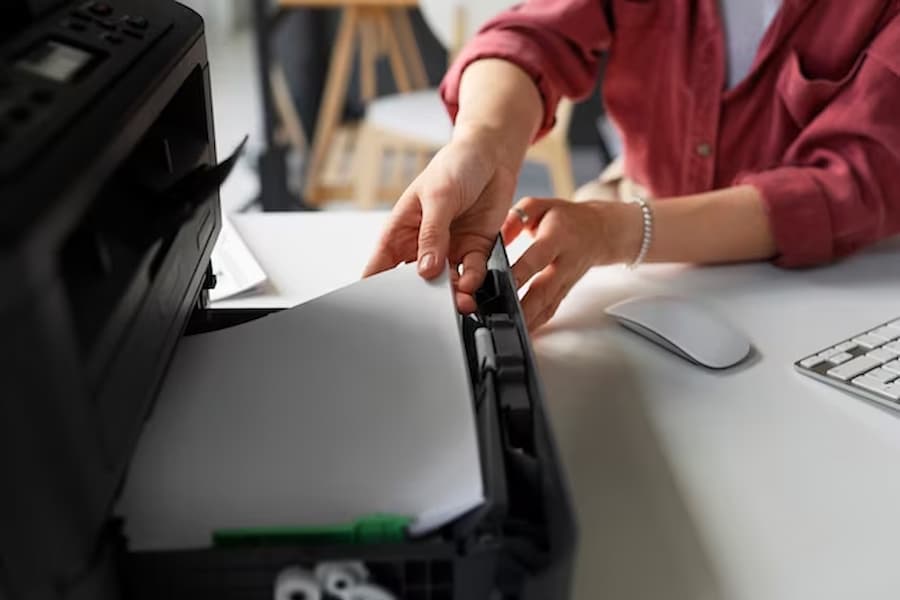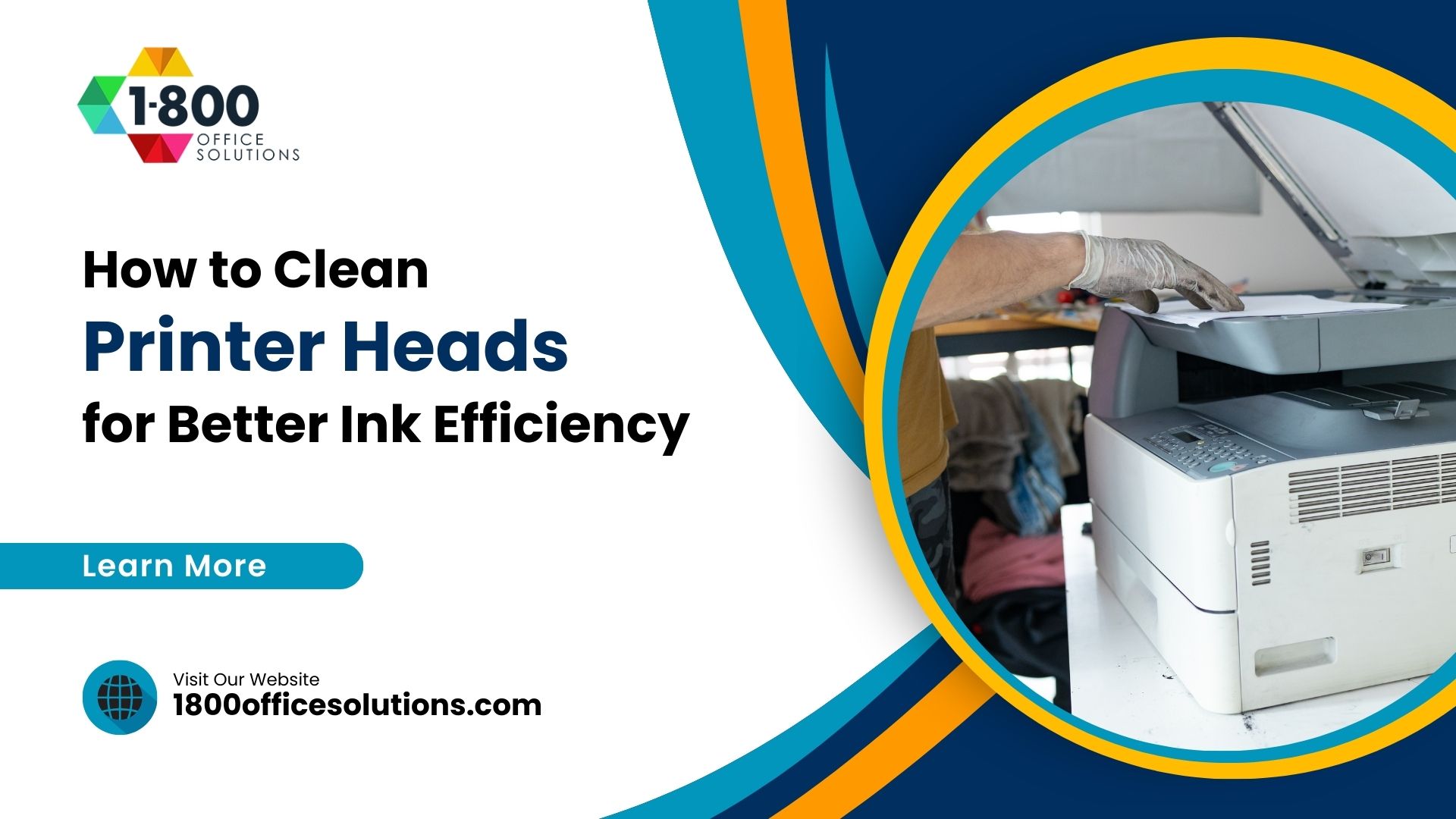10 Common Printer Problems You Can Fix Yourself
Common Printer Problems
An office printer, a multifunction (MFP) marvel, not only brings digital documents to life but also doubles as a copier and scanner, making it an indispensable cog in the business wheel. But when this vital piece of machinery falters, the echo of that malfunction reverberates through the office. From a deceptively simple paper jam to a disconcerting issue with the printer driver, these common printer problems can grind the gears of productivity to a halt. Yet, amidst the frustration and the ticking clock, many of these issues can be tackled without the need for a professional technician.
Armed with knowledge and a little patience, one can dive into the labyrinthine world of printer troubleshooting, a realm where the common problem of shoddy print quality could be solved with a simple cartridge replacement or a quick clean of the print head. The mysterious realm of wireless printer issues might only require a quick check of the router or a glance at the wireless printer settings.
1. Printer Is Unresponsive
Upon ensuring the basics, a journey into the heart of the unresponsive device commences. One may encounter an array of printer problems and their solutions. The first common issue that might arise is the silent refusal of the printer to accept a print job. This could be a result of a connection error. Ensure that the device is correctly plugged into a USB port or is connected to the same network for Wi-Fi printing.
A thorough check inside the printer may reveal an ink or toner cartridge that’s either empty or clogged. Try replacing the ink cartridges and toner cartridge with new ones. If this doesn’t solve the problem, the user manual or the troubleshooting section of the printer’s manufacturer’s website can provide a wealth of information.
Sometimes, the type of paper used can cause major printer hiccups. Ensure that the paper tray is loaded with the correct paper type and paper size. A sheet of photo paper or a stack of paper that’s not suitable for the printer model might be the culprit. If the problem persists, try reinstalling the driver for your printer or make sure the firmware is up to date.
In the event the printer is still unresponsive, it might be a software issue. Check for software updates and make sure you’re using the right print settings. If that doesn’t fix the issue, it might be time for a new printer.
2. Printer Won’t Print
Emerging from a state of unresponsiveness, the next hurdle one might encounter is a printer that refuses to print. Transitioning into this new realm of issues, a meticulous check of the printer, from its placement to whether it’s connected via USB or wireless access to a network, becomes critical.
Starting with surety that the printer is still connected and appropriately placed may save unnecessary troubleshooting. But if an error message flashes on the control panel, it signals a deeper issue. The common cause of such issues can range from ink or toner cartridges being empty or issues with cloud printing.
A laser printer, for example, might stop working due to a sheet of paper misalignment. In such cases, consulting the printer manual or checking the troubleshooting section could offer valuable steps to fix the problem. If the printer still isn’t responding, trying to move the router can improve wireless printing performance.
A common complaint among users is the printer speed. This is particularly true when trying to print photos or large documents. Loading paper correctly, checking ink and toner levels, and adjusting the printer placement can help solve this issue. However, if this doesn’t solve the problem, one might have to delve deeper into the types of problems and how to fix them. Remember, it’s important to get your printer working again to ensure it can handle printing problems.
3. Bad Print Quality
Transitioning from uncooperative devices to subpar printing results, let’s delve into the world of less-than-desirable print quality. Often, the culprit behind this issue isn’t something as straightforward as a stubborn device or a faulty connection, but rather a mismatch between the machine’s print settings and the material being printed on.
Before blaming the device, check the printer for any inconsistencies in its configurations. This is a critical step in the quest to fix printer quality issues. But what if this doesn’t solve the problem? Then, it’s time to examine the material. Using photo-grade sheets from the device’s maker can drastically improve results, more so than generic materials. But that’s not all; using a single type and brand of material in one load can also prevent further complications.
Laser printers are the epitome of precision and speed, but even they are not immune to these challenges. If a laser device stops working as expected, take a moment to ensure that the printer is set to the right configurations for the material in use. This is a common source of complaints and a common printing concern among users.
So, what steps can you take to resolve the issue? For starters, try moving the router closer to the device for a stronger connection.
4. Uncertain About Printer Security
Shifting focus from the mundane hues of poor print quality, let’s journey into the shadowy realm of cybersecurity, a critical concern often overlooked in the realm of printing devices. Imagine a fortress, your business network, with its guards, firewalls, and security systems. However, an inconspicuous backdoor, your printing device, might compromise this fortress’s security if not adequately protected.
Now, one might wonder, how could a simple printing device pose such a risk? Shockingly, if protective measures are not in place, a crafty intruder might exploit the device to infiltrate your network. The printer isn’t just a conduit for hard copies anymore, but a gateway for potential threats.
Addressing this risk requires strategic defense tactics. One of the most effective steps you can take is to alter the default password on the device, an action akin to changing the locks of your fortress. Additionally, ensuring the most recent security updates are incorporated is paramount, acting as a reinforced shield against cyber attacks.
In this digital battlefield, enlisting the support of an IT manager or a Managed Print Service provider proves invaluable. They can fortify your defenses by configuring security settings and creating a digital lockbox. To further fortify your fortress, they can set up confidential printing modes, mitigating potential internal threats.
5. My Printer Won’t Scan Anymore
Moving on from concerns about security, a completely different category of common printer issues lies in wait. Picture this: a formerly reliable MFP, now refusing to scan. This scenario is one of the common complaints heard by technicians.
Imagine a once-dependable device, now silent and unresponsive. The usually active light, signalling the scanning process, remains dim. The once smooth hum of the scanning mechanism is now replaced with an eerie silence. It’s as if the machine has lost its voice and ability to communicate.
The culprit often points towards the corrupted scanning software. Think of this as a complex, digital ballet, with a multitude of steps and sequences. When one dancer falters, the entire performance suffers. Similarly, when the scanning software becomes corrupted, the scan function fails to perform.
To fix this issue, one must approach it as a detective would a mystery. Delve into the bundled software package and attempt a reinstallation. This is akin to recasting the dancers in the digital ballet, hoping for a more harmonious performance.
If this doesn’t restore the harmony, then it’s time to check the troubleshooting section of the device’s instruction manual. It may feel like navigating through a labyrinth, but often the answers lie within.
If the uncooperative MFP remains stubborn, it may be time to consult the manufacturer’s website for your specific model.
6. Too Many Paper Jams
Transitioning from scanning snags to the next gripping challenge: overwhelming blockages in the document passage. An insidious frustration, akin to a rush-hour traffic jam on your favorite highway. This scenario can feel like an endurance test for your patience, testing the limits of your tolerance.
A plenitude of potential culprits lurk in the shadows, ready to sabotage the smooth operation of your document handling device. Perhaps an unsuspecting foreign object has found its way into the document passage, causing unexpected blockages. Or, the document feeding area might be choked with an excess of material, disrupting the steady flow.
A simple remedy could be to aerate the documents, dispersing any static cling and dust. Reintroduce the documents to the feeding area, ensuring they align harmoniously with the guides. As for thicker material, it may be more beneficial to introduce each document individually through an alternative feeding area.
To use your device without such interruptions, ensure a strong connection to your wi-fi network. This can help minimize disruptions in the document handling process, and ensure a smoother operation overall. Remember, like a well-organized traffic system, the key is to keep things moving along at a steady and manageable pace.
7. Prints Too Slowly
Drawing a curtain on the issue of paper jams, let’s now glide into the realm of sluggish printing. Imagine a scenario where deadlines are looming, and the device seems to be taking an eternity to produce a single document. Frustrating, isn’t it?
Understanding the factors that influence the pace of document production can open avenues to expedite the process. One of the key considerations is the complexity of the document being produced. A plain text file will generally be produced quicker than a richly detailed image or a multi-layout document. This is due to the intricate process the machine has to undertake in interpreting and reproducing such complex data.
When it comes to harnessing speed in document production, simplicity is the ultimate sophistication. The less intricate the settings, the swifter the process. For instance, opting for draft quality instead of presentation quality can significantly increase the speed of document production.
Moreover, the use of duplex mode – producing text or images on both sides of the folio – can contribute to the perception of sluggishness. This is because the machine needs time to flip the folio over. If speed is your primary goal, it may be a wise decision to use your printer in simplex mode – reproducing on one side of the folio only. Finally, remember that a well-maintained device is likely to perform better and faster.
8. Printing Is Too Expensive
Emerging from the labyrinth of slow printing, one stumbles upon the intimidating fortress of excessive expenditure. Oblivious to the potential pitfalls, the unsuspecting user might squander resources on superfluous text, imagery, and stationery.
Consider the following scenario: a document, bloated with unnecessary pages. Is every leaf essential? Perhaps only a few are truly needed. Or, contemplate the potential for duplex or two-sided production. This simple shift could result in dramatic savings.
Equally consequential is the choice of consumables. Are they genuinely compatible with the equipment? Are they procured from a trustworthy source? Unearthing cheaper, third-party materials may seem enticing but beware. Such shoddy supplies often result in substandard output and frequent replacements, draining resources unexpectedly.
A collective approach to production norms among team members could result in substantial savings. Establishing shared standards and ensuring adherence could lead to a more cost-effective operation.
Contemplating an even more progressive approach? Consider the adoption of a paperless system. An electronic content management platform could store and route documents through the digital ether, aligning the organization with eco-friendly goals. This virtual vault could serve as a cost-effective, green alternative to traditional printing methods.
In this realm of extravagant expenditure, a few thoughtful choices could pave the way to significant savings and sustainable practices.
9. I Can’t Print From My Mobile Device
Stepping away from concerns regarding costly output, let’s turn our attention to the realm of mobile devices. Picture this: your handheld gadget, a powerful tool in its own right, becoming an extension of your printing equipment.
Imagine pressing a button on the sleek screen of the handheld device, initiating an invisible communication with your printing unit. This seamless interaction can make printing documents, from photos to contracts, as easy as a flick of the thumb. However, sometimes the communication isn’t as effortless as one would hope.
Frustration might bubble up when the document, so vivid on the bright screen, refuses to appear in physical form. Confusion might follow as one struggles to understand why the device, usually so reliable, falls short in this task. This could be due to a multitude of reasons – outdated applications, incompatible software, or even a lack of communication between the mobile device and the printing unit.
Before throwing hands up in frustration, consider updating the applications or ensuring that the mobile device and the printing equipment are speaking the same language. Compatibility is key and ensuring that the software on both the handheld and the printing unit are up to date and matched, can alleviate many headaches. Additionally, one must ensure that an appropriate access point is in place, serving as a bridge for the devices to communicate.
10. Wi-Fi Printing Takes Too Long
Emerging from the labyrinth of mobile device printing, one now steps into the realm of sluggish connectivity and prolonged printing intervals. It’s a world where the speed of transferring data across digital airwaves reigns supreme.
Picture this: the printing device and the digital broadcasting unit sit in close proximity, like two old friends sharing a cup of tea on a Sunday afternoon. Yet, the exchange of data between them is a slow, tedious waltz. The culprit? Not the machine that spews out your documents, but the method of data transfer itself.
In this scenario, bringing the two entities closer might be a viable solution, like dancers stepping closer in for a slow dance. However, if this physical repositioning isn’t feasible, an examination of the broadcasting unit’s capabilities becomes necessary. Does it support 802.11n? Are its firmware and band offerings up-to-date?
Here’s a trick: switch to a tethered connection and then revert back to the untethered one. This digital ‘reset’ could possibly resolve the issue.
If all else fails, consider a service agreement for the next digital document creator you bring into your office. Having an expert on speed dial can save precious time and deter rising frustration. A managed print service might just be the answer to these perplexing scenarios. Consult the infographic below to ascertain its benefits.
Conclusion
Grasping the essence of the machine’s functionality and common hiccups, one can effortlessly keep the device in optimal condition. From being unresponsive to slow speed, costly operation, or mobile integration issues, each hurdle can be overcome with a little patience and understanding.
To fine-tune the image quality, secure the device, and ensure smooth scanning, one need not always seek professional help. Armed with the right knowledge, anyone can maintain reliable, efficient, and cost-effective operation, enhancing the overall user experience and longevity of the apparatus.













